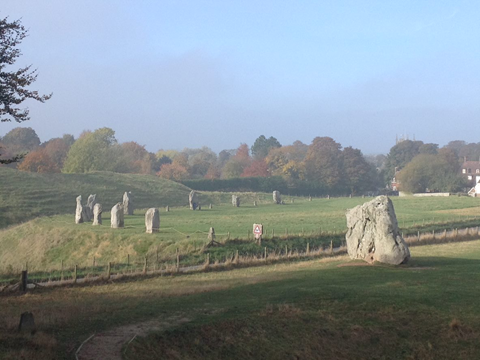Therapeutic Landscapes of Prehistory: Exploring the role of archaeology in the promotion of present- day wellbeing
By Claire Nolan
This project sought to examine the relationship between heritage and wellbeing, focusing in particular on how heritage assets/the historic environment directly influence individual lived experience and wellbeing.
Undertaken as an AHRC-funded PhD study at the University of Reading, the project first carried out an extensive literature review of heritage-related wellbeing projects. Based on this research the study set out to achieve its additional aims through a site-specific, qualitative study of resident and visitor responses to prehistoric landscapes in Wiltshire (Stonehenge and Avebury WHS, the Vale of Pewsey, and their environs). As such, the study also aimed to identify qualitative methods capable of discerning the direct value – whether intellectual, emotional, affective, physical or spiritual – that the heritage assets in themselves possess for participants. In addition, it examined how and why this value manifests for the participants.
Methods included: 40 personal audio-recorded interviews (33 individual and seven joint) with residents of the study area; 13 written reflective participant accounts; three mindful heritage walks in the Avebury landscape and corresponding audio-recorded group interviews, with two groups of nine undergraduate/postgraduate students and one group of nine residents. 66 participants were recruited in all, through a mixture of purposive, snowball, convenience and volunteer sampling methods.
As heritage experience is often intangible and difficult to express, the study employed phenomenological theory and methods drawn from psychotherapy, psychology, archaeology and geography in order to enable participants to reflect more deeply on their day-to-day and in-the-moment perceptions of the archaeology.
The study found that, for some participants, the sites examined appear to support the development of existential wellbeing. In this context, existential wellbeing refers to the sense of ontological security, existential relatedness and existential possibility that the narratives, age, character and aesthetic or physical agency of the assets can elicit for people.
Societal challenges
This project addressed the societal challenge of improved wellbeing identified by the NHSF research working group.
The study developed a sophisticated body of theory on what it is about cultural heritage assets/the historic environment that facilitates wellbeing, the type of wellbeing they facilitate, and how this experience relates to identity, sense of place and belonging. The existential wellbeing indicators identified in this study may serve as a basis for the development of a set of sector-specific measures that can be applied to quantitative evaluations of heritage-related wellbeing. Likewise, the phenomenological methods used might also be improved upon and honed for routine use in the evaluation of heritage experience more generally.
The research revealed the sense of ontological security, existential relatedness and existential perspective that can be experienced in response to one’s historic environment. The results of the study suggest that these aspects of existential wellbeing are responsible, at least in part, for the sense of identity, place and belonging that the historic environment is thought to facilitate. The success of the methods used suggests that providing members of the public with the opportunity to reflect on their interaction with cultural heritage is key to maximising the level of wellbeing they can obtain from it.
Impact of initiative
In terms of immediate social, cultural and educational impact, many of the research participants enjoyed and benefited from their involvement in the project. A number of the personal interview participants reported that the research methods and process helped them reflect on their interaction with their historic environment, to value it more and to identify positive impacts it has on their lives which they had not recognized previously. Participants from the student and community groups who engaged in the reflective walks at Avebury confirmed that they enjoyed the experience, reporting that they found it thought-provoking, educational, illuminating, calming and enriching.
With regard to wider, long-term impacts, the methods piloted as part of the study provide a toolkit for future site-specific studies on heritage experience. Likewise, the study has so far produced a PhD thesis (Nolan 2019a), five publications (Nolan 2017, 2019b, 2019c, 2019d; Reilly et al. 2018) and numerous talks and conferences presentations.
The main beneficiaries were the project participants, academics, students and policymakers, the latter of whom benefitted in particular from the findings of the Historic England report (Reilly et. al. 2018), Wellbeing and the Historic Environment, which formed part of the literature review for this study.
Further information
The project was completed in 2019. You can read more about its findings here and in the resources below.
References/Further Reading
Nolan, C. 2017. ‘Life in Ancient Landscapes’, Current Archaeology, 329, 47-49.
Reilly, S., Nolan C., Monckton L. 2018. Wellbeing and the Historic Environment: Threats, Issues and Opportunities for the Historic Environment, Historic England, 1-79. Online Resource: https://historicengland.org.uk/images-books/publications/wellbeing-and-the-historic-environment/wellbeing-and-historic-environment/
Nolan, C. 2019a. Therapeutic Landscapes of Prehistory: Exploring the Role of Archaeology in the Promotion of Present-Day Wellbeing. Unpublished PhD thesis, University of Reading.
Nolan, C. 2019b. ‘Prehistoric Landscapes as a Source of Ontological Security for the Present Day’, Heritage and Society, 12(1), 1-25.
Nolan, C. 2019c. ‘Sites of Existential Relatedness: findings from phenomenological research at Stonehenge, Avebury and the Vale of Pewsey, Wiltshire, UK’, Public Archaeology, 18(1), 28–51.
Nolan, C. 2019d. ‘Prehistoric Landscapes as Transitional Space’, in T. Darvill, K. Barrass, L. Drysdale, V. Heaslip, & Y. Staelens, (eds.) Historic landscapes and mental well-being. Oxford: Archaeopress.
Nolan, C. 2022. ‘The Historic Environment: Friend or Foe?’. Changing Landsapes, Changing Lives Blog, 10th January. Online resource: https://research.reading.ac.uk/changing-landscapes/the-historic-landscape-friend-or-foe/

Image: Avebury Stone Circle
This case study has been shared under Creative Commons License - CC BY-NC 4.0 (https://creativecommons.org/licenses/by-nc/4.0/)
